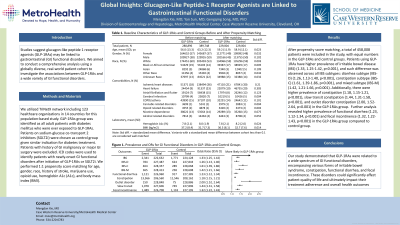Tuesday Poster Session
Category: Functional Bowel Disease
P4068 - Global Insights: Glucagon-Like Peptide-1 Receptor Agonists are Linked to Gastrointestinal Functional Disorders
Tuesday, October 29, 2024
10:30 AM - 4:00 PM ET
Location: Exhibit Hall E

Has Audio

Mengdan Xie, MD
Case Western Reserve University / MetroHealth
Cleveland, OH
Presenting Author(s)
Award: ACG Outstanding Research Award in the Functional Bowel Disease Category (Trainee)
Award: Presidential Poster Award
Mengdan Xie, MD1, Yan Sun, MD1, Gengqing Song, MD, PhD2
1Case Western Reserve University / MetroHealth, Cleveland, OH; 2Metrohealth Medical Center, Cleveland, OH
Introduction: Studies suggest glucagon-like peptide 1 receptor agonists (GLP-1RAs) may be linked to gastrointestinal (GI) functional disorders. We aimed to conduct a comprehensive analysis using a globally diverse, real-world patient cohort to investigate the associations between GLP-1RAs and a wide variety of GI functional disorders.
Methods: We utilized TriNetX network including 123 healthcare organizations in 14 countries for this population-based study. GLP-1RAs group was identified as all adult patients with diabetes mellitus who were ever exposed to GLP-1RAs. Patients on sodium-glucose co-transport 2 inhibitors (SGLT2i) were chosen as control group given similar indication for diabetes treatment. Patients with history of GI malignancy or major GI surgery were excluded. ICD codes were used to identify patients with newly-onset GI functional disorders after initiation of GLP-1RAs or SGLT2i. We performed 1:1 propensity score matching for age, gender, race, history of stroke, marijuana use, opioid use, hemoglobin A1c (A1c), and body mass index (BMI).
Results: After propensity score matching, a total of 458,008 patients were included in the study, with equal numbers in the GLP-1RAs and control groups. Patients using GLP-1RAs have higher prevalence of irritable bowel disease (IBS) (1.33, 1.25-1.42, p< 0.001), and such difference was observed across all IBS subtypes: diarrhea subtype (IBS-D) (1.26, 1.13-1.40, p< 0.001), constipation subtype (IBS-C) (1.61, 1.39-1.86, p< 0.001), and mixed subtype (IBS-M) (1.42, 1.21-1.66, p< 0.001). Additionally, there were higher prevalence of constipation (1.18, 1.15-1.21, p< 0.001), slow transit constipation (1.44, 1.31-1.58, p< 0.001), and outlet disorder constipation (2.00, 1.52-2.64, p< 0.001) in the GLP-1RAs group. Further analysis revealed higher prevalence of functional diarrhea (1.23, 1.12-1.34, p< 0.001) and fecal incontinence (1.32, 1.22-1.43, p< 0.001) in the GLP-1RAs group compared to control group.
Discussion: Our study demonstrated that GLP-1RAs were related to a wide spectrum of GI functional disorders, encompassing various forms of irritable bowel syndrome, constipation, functional diarrhea, and fecal incontinence. These disorders could significantly affect patient quality of life and ultimately impact their treatment adherence and overall health outcomes

Note: The table for this abstract can be viewed in the ePoster Gallery section of the ACG 2024 ePoster Site or in The American Journal of Gastroenterology's abstract supplement issue, both of which will be available starting October 27, 2024.
Disclosures:
Mengdan Xie, MD1, Yan Sun, MD1, Gengqing Song, MD, PhD2. P4068 - Global Insights: Glucagon-Like Peptide-1 Receptor Agonists are Linked to Gastrointestinal Functional Disorders, ACG 2024 Annual Scientific Meeting Abstracts. Philadelphia, PA: American College of Gastroenterology.
Award: Presidential Poster Award
Mengdan Xie, MD1, Yan Sun, MD1, Gengqing Song, MD, PhD2
1Case Western Reserve University / MetroHealth, Cleveland, OH; 2Metrohealth Medical Center, Cleveland, OH
Introduction: Studies suggest glucagon-like peptide 1 receptor agonists (GLP-1RAs) may be linked to gastrointestinal (GI) functional disorders. We aimed to conduct a comprehensive analysis using a globally diverse, real-world patient cohort to investigate the associations between GLP-1RAs and a wide variety of GI functional disorders.
Methods: We utilized TriNetX network including 123 healthcare organizations in 14 countries for this population-based study. GLP-1RAs group was identified as all adult patients with diabetes mellitus who were ever exposed to GLP-1RAs. Patients on sodium-glucose co-transport 2 inhibitors (SGLT2i) were chosen as control group given similar indication for diabetes treatment. Patients with history of GI malignancy or major GI surgery were excluded. ICD codes were used to identify patients with newly-onset GI functional disorders after initiation of GLP-1RAs or SGLT2i. We performed 1:1 propensity score matching for age, gender, race, history of stroke, marijuana use, opioid use, hemoglobin A1c (A1c), and body mass index (BMI).
Results: After propensity score matching, a total of 458,008 patients were included in the study, with equal numbers in the GLP-1RAs and control groups. Patients using GLP-1RAs have higher prevalence of irritable bowel disease (IBS) (1.33, 1.25-1.42, p< 0.001), and such difference was observed across all IBS subtypes: diarrhea subtype (IBS-D) (1.26, 1.13-1.40, p< 0.001), constipation subtype (IBS-C) (1.61, 1.39-1.86, p< 0.001), and mixed subtype (IBS-M) (1.42, 1.21-1.66, p< 0.001). Additionally, there were higher prevalence of constipation (1.18, 1.15-1.21, p< 0.001), slow transit constipation (1.44, 1.31-1.58, p< 0.001), and outlet disorder constipation (2.00, 1.52-2.64, p< 0.001) in the GLP-1RAs group. Further analysis revealed higher prevalence of functional diarrhea (1.23, 1.12-1.34, p< 0.001) and fecal incontinence (1.32, 1.22-1.43, p< 0.001) in the GLP-1RAs group compared to control group.
Discussion: Our study demonstrated that GLP-1RAs were related to a wide spectrum of GI functional disorders, encompassing various forms of irritable bowel syndrome, constipation, functional diarrhea, and fecal incontinence. These disorders could significantly affect patient quality of life and ultimately impact their treatment adherence and overall health outcomes

Figure: Prevalence and Odds Ratios for GI Functional Disorders in GLP-1RAs and Control Groups
Note: The table for this abstract can be viewed in the ePoster Gallery section of the ACG 2024 ePoster Site or in The American Journal of Gastroenterology's abstract supplement issue, both of which will be available starting October 27, 2024.
Disclosures:
Mengdan Xie indicated no relevant financial relationships.
Yan Sun indicated no relevant financial relationships.
Gengqing Song indicated no relevant financial relationships.
Mengdan Xie, MD1, Yan Sun, MD1, Gengqing Song, MD, PhD2. P4068 - Global Insights: Glucagon-Like Peptide-1 Receptor Agonists are Linked to Gastrointestinal Functional Disorders, ACG 2024 Annual Scientific Meeting Abstracts. Philadelphia, PA: American College of Gastroenterology.

